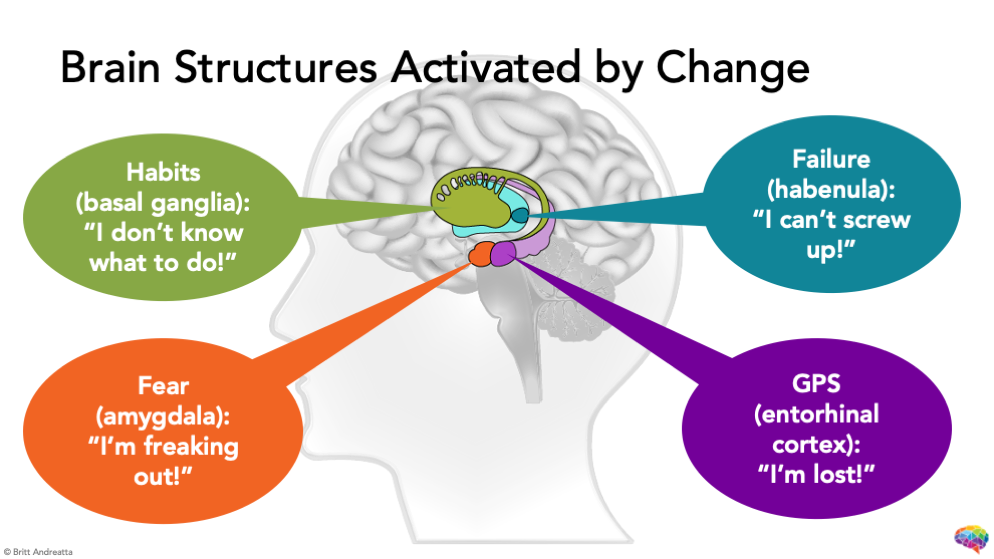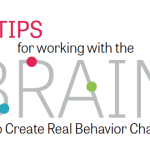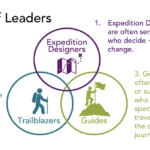New Brain-Based Tools for Launching Successful Change (1 in 3-part series)

"It is not the strongest of the species that survives, nor the most intelligent, but the one most responsive to change." - Charles Darwin
Every year failed change costs billions of dollars. The reason 50-70% of change initiatives fail is that typical change management products don't take into account human biology and that humans are wired to resist change. Change actually activates key brain structures that together drive fear, failure, and fatigue. Without intentionally counterbalancing them, change initiatives are often doomed from the start. The success of any change initiative lives in your ability to help get people (employees, clients, stakeholders) through it without harming the culture or trust in your organization.
In addition, change fatigue is a real and growing problem. Nearly half of executives believe that change fatigue is prevalent in their organization. While resisting change is part of our survival response, it often gets in the way of people and organizations being able to fulfill their potential. Understanding the brain science of change allows you to reduce change fatigue while increasing adaptability and resilience, all of which can impact important business metrics like productivity, engagement, retention and customer satisfaction.
Four Brain Structures Involved With Change
Many brain structures relate to change but I believe these four, in particular, are crucial to understanding: the amygdala, the entorhinal cortex, the basal ganglia, and the habenula. I have been sharing the results of my research with executives around the world and every single one immediately saw the implications for their organizations and their people. And each one could identify several key issues that were not being addressed in their change plans.
1.The Amygdala
The amygdala is largely responsible for our survival. It's designed to detect threats in our environment and it does this by scanning for change. When a potential threat arises, like the smell of fire smoke, seeing an attacker, or hearing a gunshot, the amygdala launches the fight-flight-freeze response.
The amygdala is what drives the many challenging emotions affiliated with the announcement of change like denial, fear/anxiety, anger, and frustration. Part of leading change successfully is understanding and being prepared for the powerful fear response. When leaders and managers are ready for the side effects of the amygdala, they are much more likely to help their people through the change curve effectively and increase the likelihood of success for the change initiative. If the amygdala could talk during a change, it would say, "I'm freaking out!"
2.The Entorhinal Cortex
As I explored the brain science of change, I discovered that our brain has an internal geographical positioning system (GPS) that helps us navigate our way through both physical space and social relationships. The entorhinal cortex sits within the hippocampus and is responsible for our GPS capabilities. It contains a spherical cluster of cells that actually make maps of our physical surroundings and helps us successfully navigate our way through them.
What does this mean for change in today's workplace? Many changes may affect people's mental maps of their physical workplaces. We might move the location of an employee's workstation or office, or we might move certain services or resources, like where food can be found or the location of the tech support team. In the case of a relocation or acquisition, every single aspect of the work environment might be disrupted and replaced with something new and unfamiliar.
In addition, the entorhinal cortex tracks social relationships, noting power and affinity. Many change initiatives shift who people work with, essentially erasing their social maps, forcing the brain to build new ones.
Fortunately, the brain can and will build new mental maps. But this process takes some time and energy as the person navigates the change. That's part of the reason we feel mental and physical fatigue when we start something new or go through a big change-the map-making part of our brain is doing some heavy lifting for physical space and/or social relationships. When impacted by the change, the phrase for the entorhinal cortex would be, "I'm lost."
3.The Basal Ganglia
Another brain structure involved with any change is the basal ganglia, which is responsible for taking behaviors we do frequently and turning them into habits. You constantly experience the benefits of your basal ganglia. When you learn something new, like how to use your smartphone or a piece of software, it is the basal ganglia that changes the activity from something challenging that requires a lot of concentration to something easy that you don't even have to think about.
Obviously, when we initiate change, we are likely to impact the well developed
habit loops that people already have in place. In all my years of consulting, I cannot think of a single change initiative that didn't require people to shift their behaviors in some profound way. Whether it's moving to a different email system, selling or marketing to a new type of client, or creating an innovative product, change involves building new habits and, worse, leaving comfortable old habits that are easy to do and have predictable rewards.
Change requires people to focus and concentrate until they sufficiently learn the new behaviors and develop habits. We often expect people to build a new habit without offering compelling rewards for doing so. In fact, the new way usually takes more time and energy than the old way (at least at first), which can seem more like a punishment to the brain. Is anyone really surprised, then, that so many change initiatives fail? During the change, the basal ganglia would say, "I don't know what to do."
4.The Habenula
The habenula is responsible for decision-making and actions. It does this by creating chemical guardrails that moderate our behavior. Our brain naturally releases dopamine and serotonin, the "feel good"chemicals, when we do something right. This is part of the brain's reward system. You probably feel it when you accomplish a task or receive praise for a job well done. However, when we make a poor choice that does not lead to a reward, the habenula restricts the flow of those chemicals, cutting off the drip so to speak, making us feel bad.
Understandably, the habenula is going to activate during change initiatives because change creates so many opportunities to fail. Change brings opportunities to fail, and when we do, our brains and our bodies become more and more resistant to embracing future changes. I believe our previous lack of understanding about the habenula has contributed to the high failure rate of change initiatives. During the change, the habenula's phrase would be, "I can't mess up."
As we consider how all of these brain structures work together, you can begin to see why, over time, people can become less flexible and adaptable to change and, worse, more anxious and worried about it. Our brains can begin to associate "change" of any kind with fear, failure, and fatigue, becoming a vicious cycle that impacts both employees and leaders. You could be rolling out the best-designed and most effective change your organization has ever seen, but its success depends on what else is happening or has happened in the past. But here's the good news: We can use the way the brain works to our advantage. The same structures that create challenges can be harnessed to create success.
The Brain Science-Based Approach For Leading Change
I'm thrilled to share my new training solution, Change Quest is available now! This brain-based model has proven to be highly effective in driving successful change of all kinds.
- Discover the four brain structures that are activated by change and how together, they drive fear, failure, and fatigue.
- Gain new tools for assessing the levels of resistance you can expect to see and strategies for moving people through them quickly.
- Learn how simple changes in how you launch change initiatives can help calm the nervous system and reduce resistance change.
- Support your entire organization with brain-based change strategies for leaders, managers, and employees.
100% of the organizations using Change Quest® learning solution find it be a game changer for leading effective change. Join them.
Related Blogs
JOIN OUR COMMUNITY
Be the first to know of Dr. Britt Andreatta's latest news and research.




